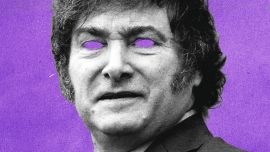Before the Buenos Aires Herald made its name battling the 1976-1983 military dictatorship, I thought that if the newspaper ever got a mention in the history books, it would be because of the time it helped bring two geniuses together, namely Jorge Luis Borges as writer and Hermenegildo Sábat as illustrator of The Book of Imaginary Beings.
The two worked together because a young American, Norman de Giovanni, was translating Borges’ stories and poems into English, seeking a wider international readership for an author who was considered difficult and obscure at the time. Sábat had resigned from Primera Plana, which was then Argentina’s leading news magazine. And so ‘Menchi’ had the time to bring his extraordinary talents to the fore, blending his and Borges’ imagination. And, for a few glorious months, Menchi was illustrating events exclusively for a small English-language newspaper in Buenos Aires.
Sábat follows in the tradition of Henri Daumier, whose caricatures were a commentary on politics and society in 19th-century France, as well as the great British cartoonists, from Rowlandson to Searle, and the Spanish visual journalists known as dibujantes. And he may even be likened to Pablo Picasso, whose painting Guernica was a commentary on the Spanish Civil War. Sabat’s greatest work, in my opinion, was when he reported graphically (he never used words in his drawings) what was happening during the military dictatorship. The silence of the major media was broken by Sábat. He drew devastating portraits of the military murderers. I remember seeing a caricature in Clarín of military junta member Emilio Massera, at the height of the terror. Menchi drew Massera smiling at his reflection in a mirror. The essence of the evil admiral was there for all to see: a killer shark in love with himself. I trembled at the thought of what might be the reaction. Yet incredibly, Massera saw no criticism in this depiction of him. His vanity had made him impervious to the message. He requested the original drawing and Sabat obliged.
In an interview last year with Pablo Calvo for Clarín, Sabat recounted the day when another military killer, Carlos Guillermo Suárez Mason, sent him a tape recording warning him that he would be thrown into the river (from one of the death flights employed to dispose of people kidnapped by the death squads) if he continued publishing his “little drawings“ of the military commanders. Sabat recalled the cartoons he drew during the dictatorship. He wondered how it was that he was still alive.
Sabat’s association with the Herald came about in the early 1960s when, having newly arrived in Argentina, I saw Sabat’s drawings in Primera Plana. Menchi, who was born in Uruguay, moved to Buenos Aires in the mid-1960s and worked in advertising, contributing illustrations to magazines in his spare time.
I was enormously impressed by his drawings. But I also was surprised that he did not touch on politics, dealing only with personalities in the art world. Ramiro de Casasbellas, the editor of Primera Plana, told me that Sabat refused to depict political figures because he had suffered an unfortunate experience while working as an editor of a daily newspaper in Montevideo. I cannot vouch for it, but my insistence with Casasbellas that Menchi’s critical eye was essential for full national coverage may have helped to lift his self-imposed limitations.
Menchi did maintain the selfdiscipline of never using words. His genius was such that he was able to capture reality with a few strokes of his pen. After surviving the ire of the military, Menchi was armoured enough to withstand any attempt by governments to intimidate him.
He was tested again by then president Cristina Fernandez de Kirchner, who objected to his depiction of her and accused him of sending mafia-like messages and of misogyny. Behind the scenes, however, the ex-president sought reconciliation. While Menchi did not reject her request for a meeting, he did not pursue the opportunity to ingratiate himself with her.
Here, for the sake of journalistic form, I am required to write that the incomparable Sabat died on Monday night (October 1, 2018) at the age of 85. But I do not believe it is so. His talent was so incandescent that he is everywhere. His influence can be seen in advertising, throughout the media, in museums and art galleries. I am sure that the loss of Sabat’s continuous output of drawings for Clarín since 1973 will be more than compensated for by the discovery of his work as an artist. His prolific production of canvases will emerge and yet another perspective of his genius will be seen.
Sabat’s legacy, for Argentine society and for journalists specifically, is the value of personal integrity. His personal life and his public persona were one and the same. He was an exemplary human being who deservedly lived a good life, to which his wife, Blanca, sons Rafael and Alfredo, friends and colleagues bear witness. He died peacefully in his sleep. The treasure of this multi-faceted genius – who embraced poetry, photography, music, teaching and friendship – has yet to be fully revealed.























Comments